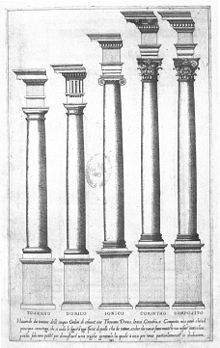Tuscan order



The Tuscan order (Latin Ordo Tuscanicus or Ordo Tuscanus, with the meaning of Etruscan order) is one of the two classical orders developed by the Etruscans, the other being the
In its simplicity, the Tuscan order is seen as similar to the Doric order, and yet in its overall proportions, intercolumniation and simpler entablature, it follows the ratios of the Ionic. This strong order was considered most appropriate in military architecture and in docks and warehouses when they were dignified by architectural treatment. Serlio found it "suitable to fortified places, such as city gates, fortresses, castles, treasuries, or where artillery and ammunition are kept, prisons, seaports and other similar structures used in war."
Italian writers on architecture
From the perspective of these writers, the Tuscan order was an older primitive Italic architectural form, predating the Greek Doric and Ionic, associated by Serlio with the practice of rustication and the architectural practice of Tuscany.[3] Giorgio Vasari made a valid argument for this claim by reference to Il Cronaca's graduated rustication on the facade of Palazzo Strozzi, Florence.[4] Like all architectural theory of the Renaissance, precedents for a Tuscan order were sought for in Vitruvius, who does not include it among the three canonic orders, but peripherally, in his discussion of the Etruscan temple (book iv, 7.2–3). Later Roman practice ignored the Tuscan order,[5] and so did Leon Battista Alberti in De re aedificatoria (shortly before 1452).
Following Serlio's interpretation of Vitruvius (who gives no indication of the column's capital), in the Tuscan order the column had a simpler base—circular rather than squared as in the other orders, where Vitruvius was being followed—and with a simple torus and collar, and the column was unfluted, while both capital and entablature were without adornments. The modular proportion of the column was 1:7 in Vitruvius, and in Palladio's illustration for Daniele Barbaro's commentary on Vitruvius), in Vignola's Cinque ordini d'architettura (1562), and in Palladio's I quattro libri dell'architettura (1570).[6] Serlio alone gives a stockier proportion of 1:6.[7] A plain astragal or taenia ringed the column beneath its plain cap.
Palladio agreed in essence with Serlio:
The Tuscan, being rough, is rarely used above ground except in one-storey buildings like villa barns or in huge structures like Amphitheatres and the like which, having many orders, can take this one in place of the Doric, under the Ionic.[8]
Unlike the other authors Palladio found Roman precedents, of which he named the
Examples of the use of the order are the
Later spread
A relatively rare church in the Tuscan order is
In a typical usage, at the very grand
The
Tuscan is often used for doorways and other entrances where only a pair of columns are required, and using another order might seem pretentious. Because the Tuscan mode is easily worked up by a carpenter with a few planing tools, it became part of the vernacular Georgian style that lingered in places like New England and Ohio deep into the 19th century. In gardening, "carpenter's Doric" which is Tuscan, provides simple elegance to gate posts and fences in many traditional garden contexts.
See also
Notes
- ISBN 9780521837491.
- ^ The first one published.
- ^ James S. Ackerman, "The Tuscan/Rustic Order: A Study in the Metaphorical Language of Architecture", Journal of the Society of Architectural Historians 42.1 (March 1983:15-34).
- ^ "la bellezza di fuori, con ordine toscana".
- ^ Ackerman was unaware of any exception (Ackerman 1983:16), and Vignola reported that he had not found Tuscan ornaments among Roman remains ("non havendo io fra le antichità di Roma trovato ornamento toscano" [quoted in Ackerman 1983:17 note 11]); Ackerman identifies some plausibly Tuscan elements in several early 16th-century architectural drawings of unidentified Roman remains.
- ^ Palladio, Book I. 13.15–21.
- ^ Ackerman 1983 offers a comparative table of components given by each theorist, figure 1 p. 16.
- ^ The Four Books on Architecture, Chapter 12
- ^ Ackerman 1983:22.
- ^ Ackerman 1983:21 and fig. 9 (of Palladio's woodcut).
- ^ Walpole, Horace; Vertue, George (1782). Anecdotes of painting in England. Vol. 2 (3rd ed.). London: J. Dodsley. p. 275.
